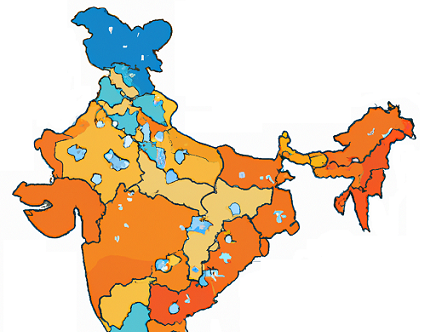Several states, including Himachal Pradesh, Gujarat, Rajasthan and Delhi, are affected by temperatures of 7 to 11 degrees Celsius higher than normal.
(Imaginary depiction)
- Bhuntar in Himachal recorded a new high of 29.7 degrees Celsius due to dry spell since February 12.
- Bhuj in Gujarat recorded the maximum temperature of 40.3 degrees Celsius.
- Delhi experienced the warmest day of the season with a maximum temperature of 29.8 degrees Celsius.
- 37-39 degrees Celsius was recorded in Saurashtra, Kutch, and southwest Rajasthan.
- 24-27 degrees Celsius was recorded in Jammu and Kashmir, Himachal and Uttarakhand.
Possible reasons for abnormal seasonal changes in temperature in India:
India is a country known for its diverse weather conditions. The climate is characterized by two main seasons, namely the summer and winter. However, in recent years, there has been an increasing trend of abnormal seasonal changes in temperature. This has led to concerns and debates among scientists, environmentalists, and policymakers.
Global warming:
The primary reason for the abnormal seasonal changes in temperature in India is global warming. The Earth's temperature has been steadily rising due to the increased amount of greenhouse gases such as carbon dioxide, methane, and nitrous oxide, in the atmosphere. These gases trap heat from the sun, causing the Earth's temperature to rise, which results in abnormal seasonal changes in temperature causing frequent dry spells regionally which in turn influence the average temperatures.
El Niño and La Niña in the Pacific Ocean:
El Niño is a weather pattern that causes warm water to move towards the eastern Pacific, which results in changes in the weather patterns across the globe. La Niña is the opposite of El Niño and causes cooler water to move towards the eastern Pacific. Both of these weather patterns can cause abnormal seasonal changes in temperature in India.
Deforestation:
Deforestation is the removal of trees from forests for commercial or developmental purposes. This has a direct impact on the climate as trees absorb carbon dioxide and release oxygen. Deforestation leads to an increase in carbon dioxide levels in the atmosphere, which results in an increase in temperature, causing abnormal seasonal changes in temperature.
Other causes
Urbanization:
India is one of the fastest-growing economies in the world, and with economic growth comes urbanization. Urbanization results in the creation of concrete jungles, which absorb more heat than natural surfaces like forests and water bodies. This leads to a phenomenon called the "Urban Heat Island Effect," which causes an increase in temperature in urban areas, resulting in abnormal seasonal changes in temperature.
Industrialization:
Industrialization is another reason for abnormal seasonal changes in temperature. Industrial activities like mining, manufacturing, and transportation emit greenhouse gases into the atmosphere, which results in an increase in temperature. Industrialization also results in the destruction of natural habitats, which further exacerbates the problem of abnormal seasonal changes in temperature.
All the above reasons have a direct or indirect relationship with each other and play an interconnected role in influencing the weather and climatic changes.
Abnormal seasonal changes in temperature in India are a cause for concern as they can have adverse effects on the environment, agriculture, and human health. It is essential to understand the reasons for these changes and take appropriate measures to mitigate their effects. Measures such as reducing carbon emissions, promoting afforestation, and implementing sustainable urbanization policies can help in the long run.


